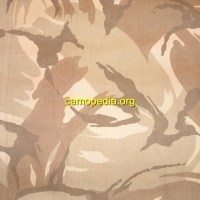DPM Desert Camouflage Pattern (UK)
The concept of having dedicated and custom camouflage patterns for certain British military units deployed in deserts/semi-deserts/dry areas of the world was seriously considered by Britain only relatively late - around the 1980s. The Americans introduced and implemented this type of camouflage pattern as early as 1981 and equipped their units in Sinai with similar camouflage on all clothing/uniforms. From about the mid-1980s, this became increasingly common for them.

British designers initially took their standard camouflage pattern type DPM (Disruptive Pattern Material) intended for the temperate zone and tried to add different colors to it - mainly brown and sand instead of green, resulting in a four-color DPM desert camouflage pattern. Since there was not yet an immediate need and necessity for deployment of this type of uniform, they were later sold to Iraq in the late 1980s. This design was subsequently licensed for production by a number of Asian companies that were sewing uniforms for Saudi Arabia, Kuwait, and other Gulf states at that time.
It was soon discovered by the British Ministry of Defence that if it really came down to it and they went somewhere in the Middle East, the British soldiers would not be distinguishable in the field from the others. This was, of course, unacceptable, so it was necessary to come up with a brand new yet still desert-type camouflage pattern. Even though a three-color version of the DPM camouflage pattern was tested at this time, it was eventually rejected because it was too similar to the original four-color version. Eventually, a two-color camouflage pattern was used (brown disruptive shapes drawn on a sand background). Over time, several other variants appeared based on this design (as well as various new types of uniforms).
The first of the camouflage patterns for sandy and desert areas produced by England was a four-color pattern based on the traditional DPM series camouflage. Although the British Army never really deployed it in action, it is believed that it was tested by its special units. It is also documented that soldiers who visited the Middle East in 1985 wore it. Uniforms marked by the British Ministry of Defence were also found among Iraqis in the first Gulf War.
As the British Ministry of Defence first tried to quickly equip its military representatives here in Saudi Arabia during the first Gulf War with any remaining sewn last piece, many of their units were initially inadequately equipped. Nevertheless, most British units received a camouflage pattern called "1st series desert DPM" and combat uniforms made from it. It had a camouflaging style similar to combat units from tropical areas. This camouflage pattern consists of a dense concentration of medium brown over sand fields. Some additional equipment (tent covers and) things intended as a windscreen appeared with this type (although here the colors were rather lighter).
A new version of desert camouflage ("2nd series desert DPM") soon began to be introduced into practice, which happened at the end of 1991. Some British soldiers here deployed in the Gulf at this time were documented wearing a combination of the first and second types. The main difference between the first and second versions of this desert camouflage pattern is that the second one has a sparser concentration of brown color compared to the older type. Therefore, it is also called "Sparse desert." However, this design was not in production for an overly long period: already in 1994, it was replaced by a new type of print for the original desert DPM.
As part of the new series "Pattern 1994," the British Ministry of Defence also introduced a series of desert-type camouflage. Just like the type intended for warmer areas, even here the type did not remain in service for more than two years. It was immediately replaced by the type and series "Soldier 95." This camouflage pattern is practically the same as the first series, only with slightly different shades.
The camouflage pattern/system "Soldier 95" was also deployed and used within the desert DPM, which necessitated a desert version of DPM. And this one is quite similar to the first in the series. The components of this were essentially the same as the version for warm areas, green, in any case, there are at least two types of shirts for the desert (Airtex / teabag and Lightweight twill).
As for the series of camouflage patterns under the "Soldier 2000" line, a desert version is also included. These mainly differ in the construction of the shirts themselves, the camouflage pattern itself is quite consistent with the previous type. However, even here the colors vary slightly depending on which specific manufacturer uses the base fabric.




























































































































